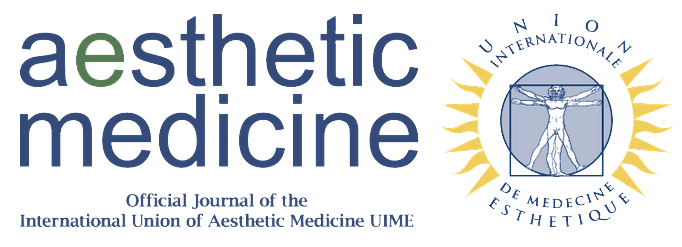A challenge in treating severe nodulocystic acne with keloid
Keywords:
keloid, minocycline, panthenol and zinc, salicylic acid, severe nodulocystic acneAbstract
Introduction: Acne vulgaris is a chronic inflammatory disease of the pilosebaceous unit that affects mainly adolescents. Acne can develop into refractory cysts, nodules and subcutaneous fistulas that are resistant to therapy. Keloid is a benign fibroproliferative tumor that occurs as a response to any kind of injury to the skin of susceptible individuals. Severe acne lesion become complicated with keloidal scars. Systemic treatment is indicated for the management of severe acne. However, we must be selective in choosing the right therapy for each condition. Case illustration: An 18 year old man presented with severe nodulocystic acne and multiple keloidal scars affecting his face, neck, upper chest and back. The patient was treated with oral minocycline (50 mg twice daily for 1 month and continued with 50 mg once daily for 2 months) along with topical salicylic acid (SA) and zinc (two times a day) as well as moisturizer containing 5% panthenol (two times a day). After 3 months of therapy, the patient showed a satisfying result and no adverse effects. Discussion: Minocycline has both antibacterial and anti-inflammatory properties. SA breaks down follicular keratotic plugs and promotes desquamation of the follicular epithelium, and has an anti-inflammatory effect. Moisturizer containing panthenol and zinc is helpful in the management of dryness caused by topical SA and its antibacterial properties help fight acne and regulate sebum production. Conclusion: These combination therapies are effective, safe, and may serve as an alternative treatment for severe nodulocystic acne with keloid formation.
References
1. Zaenglein AL. Acne vulgaris. N Engl J Med. 2018; 379(14):1343-1352.
2. Kurokawa I, Nakase K. Recent advances in understanding and managing acne. F1000Res. 2020; 9:F1000 Faculty Rev-792.
3. Kurokawa I, Layton AM, Ogawa R. Updated treatment for acne: targeted therapy based on pathogenesis. Dermatol Ther (Heidelb). 2021; 11(4):1129-1139.
4. Jfri A, Alajmi A. Spontaneous keloids: a literature review. Dermatology. 2018; 234(3-4):127-130.
5. McDonald KA, Shelley AJ, Alavi A. A systematic review on oral isotretinoin therapy and clinically observable wound healing in acne patients. J Cutan Med Surg. 2017; 21(4):325-333.
6. Martins AM, Marto JM, Johnson JL, Graber EM. A review of systemic minocycline side effects and topical minocycline as a safer alternative for treating acne and rosacea. Antibiotics (Basel). 2021; 10(7):757.
7. Conforti C, Giuffrida R, Fadda S, et al. Topical dermocosmetics and acne vulgaris. Dermatol Ther. 2021; 34(1):e14436.
8. Goh CL, Abad‐Casintahan F, Aw DC, et al. South‐East Asia study alliance guidelines on the management of acne vulgaris in South‐East Asian patients. J Dermatol. 2015; 42(10):945-953.
9. Aryal E, Bhattarai E, Bhattarai S. Zinc therapy in dermatology: A Review and Update. Nepal Journal of Dermatology Venereology & Leprology. 2021; 19(1):3-8.
10. Lueangarun S, Srituravanit A, Tempark T. Efficacy and safety of moisturizer containing 5% panthenol, madecassoside, and copper‐zinc‐manganese versus 0.02% triamcinolone acetonide cream in decreasing adverse reaction and downtime after ablative fractional carbon dioxide laser resurfacing: A split‐face, double‐blinded, randomized, controlled trial. J Cosmet Dermatol. 2019; 18(6):1751-1757.
Downloads
Published
Issue
Section
License
Copyright (c) 2025 Eka Syahrini, Rudi Chandra

This work is licensed under a Creative Commons Attribution-NonCommercial 4.0 International License.
This is an Open Access article distributed under the terms of the Creative Commons Attribution License (https://creativecommons.org/licenses/by-nc/4.0) which permits unrestricted use, distribution, and reproduction in any medium, provided the original work is properly cited.
Transfer of Copyright and Permission to Reproduce Parts of Published Papers.
Authors retain the copyright for their published work. No formal permission will be required to reproduce parts (tables or illustrations) of published papers, provided the source is quoted appropriately and reproduction has no commercial intent. Reproductions with commercial intent will require written permission and payment of royalties.

This work is licensed under a Creative Commons Attribution-NonCommercial 4.0 International License.





